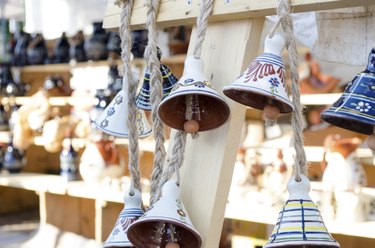
Craft-making represents only half of the equation when you want to make it a business -- the other half depends on an entirely different set of skills: pricing, marketing and selling. To increase your profits when selling goods at a crafts fair, have multiple items that sell at different price points; know the local market and what it wants, and choose a good spot at the fair to get the most exposure.
Pricing Products
Video of the Day
An item's price represents a balance of the materials, supplies and expenses needed to make it, the work you put into it and how much you expect others to pay for it. If any of these are skewed, you'll end up either selling items at a loss or not making any sales at all. In business, retailers use a keystone markup, where the cost of the item is marked up 100 percent for a 50 percent profit. Add materials, supplies, expenses and your hourly labor costs together, divided by the number of items made to arrive at the total cost to make the item. Increase that amount 100 percent for a keystone markup, which results in a 50 percent profit margin. For example, items that cost $7 to make would retail for $14. You make a 50 percent profit -- not including your labor costs.
Video of the Day
The Venue and Customers
Successful crafts sales are all about the venue, the location, the weather, and the number of participants who set up booths or tents at the fair. Most of these factors are beyond your control -- but with knowledge of the market, the prices people pay for crafts and the products they prefer, add more of those products to increase your profits during the craft fair. Or make something different at a lower price point to increase sales and profits.
Multiple Items and Prices
A booth at a craft fair that offers items at multiple price points, from low to high, and provides a wide sampling of products, has a better chance of increasing its profits than someone who only carries one item at one price. The more varied your inventory and its prices, the more your chances of selling increase.
Combination Sales
Include visible price tags on your pieces, because most people won't bother to ask the price of an item unless they are especially interested. If you have two similar or complementary products that sell individually for $10 and $15, combine them at a lower price point to make more sales. Offer to sell the two together at $20, which increases your chances of making more sales. Carefully examine your inventory to determine products you can combine for increased sales.
Creative Sales Incentives
Get creative with your products and sales. Add a free item to purchases of set minimum amounts -- and advertise it in your booth. Set price points that include a discount; for example, if someone buys $50 worth of goods from you, advertise a 10 percent discount. The more they spend, the bigger the discount. Include personalized gift items at your booth. People often shop at craft fairs for gift items; if you can personalize it free of charge, you can increase both your sales and your profits. Offer delayed pickup, shipping or prepaid orders to increase profits.
Location, Location, Location
The sooner you sign up for a craft fair, the better chance you have of choosing a good spot. Fair organizers often charge more for the premium locations, such as where the traffic enters the fair, but other choices might be better. A location adjacent to where food and drinks are sold provides more exposure for your goods. A booth adjacent to another vendor that complements your inventory creates a chance for more sales.